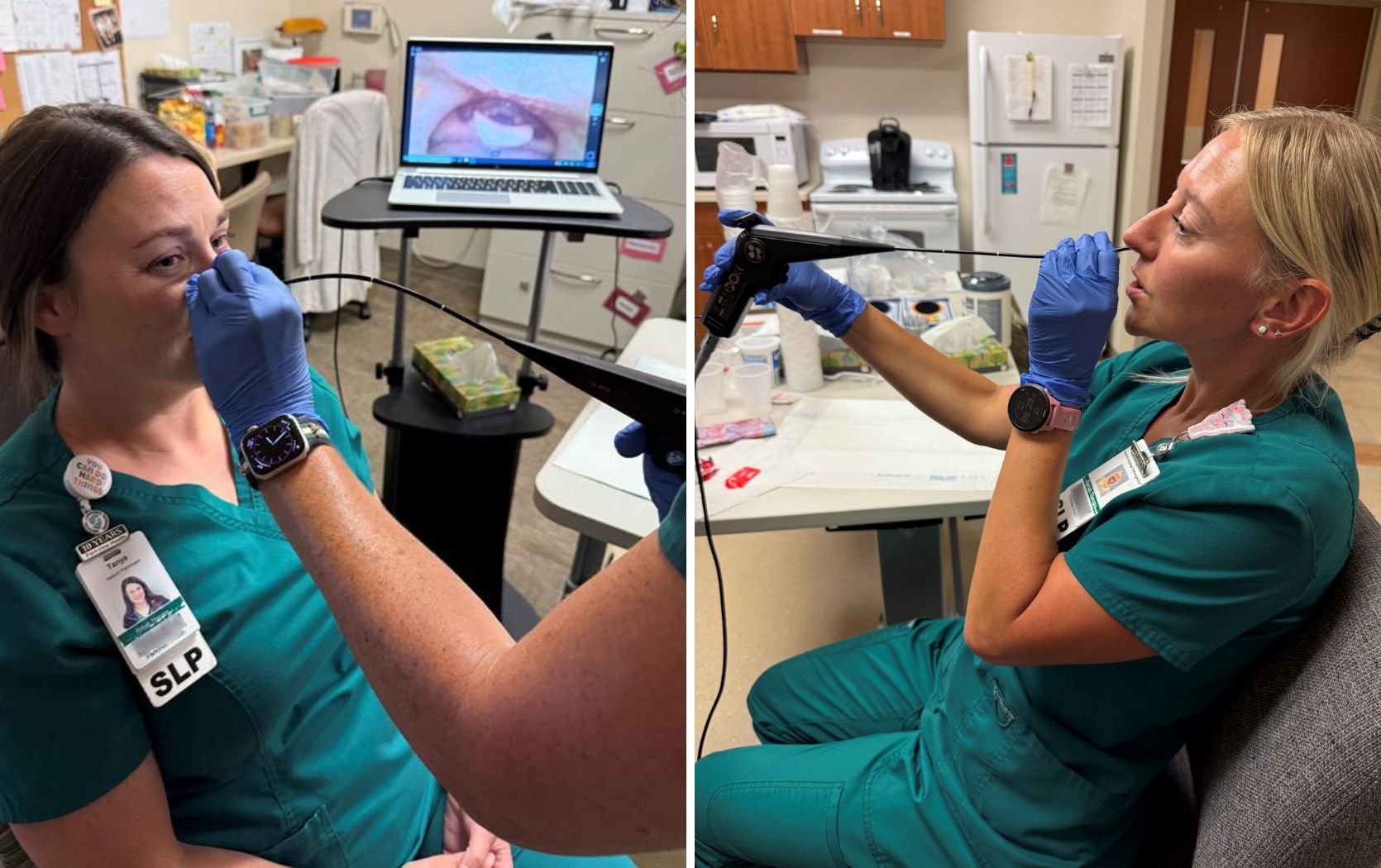
It might surprise you to know that asthma affects the health and well-being of over 26 million Americans, with 7 million of those being children. In honor of Asthma Awareness Month, we turn to Denise Gilham, NP, PPG - Pediatric Specialties, Pulmonology and Critical Care, for answers to our questions and some helpful management strategies for children and families dealing with the condition.
What is asthma?
Asthma is a chronic, long-term, inflammatory disease of the airways. When a child is exposed to a trigger, the lining of the lungs, upper airway and sinuses can become swollen and inflamed. In more severe cases, some children may even experience spasming or tightening of the muscles around the airways, leading to increased mucus production, making it difficult to breathe. Additionally, asthma can present differently in each person. For some children, it may be a minor issue. For others, it could be more serious, interfering with daily activities and lead life-threatening asthma attacks.
What causes asthma in children?
The causes of asthma aren’t fully understood. There is a genetic component or link, and those with family members who have allergies and asthma do tend to inherit the condition. This factor is usually a strong indicator of whether a patient will have lifelong asthma versus childhood asthma. Some types of airway infections may also contribute to the development of the condition, making some children more susceptible to developing asthma later in life.
Scientific studies also show that environmental factors play a major role as well. For example, air pollution, mold and secondhand smoke can put some children at an increased risk for developing asthma and worsen symptoms for those who already live with the disease. In many cases, children who already suffer from allergies are also more likely to have asthma. However, with all this in mind, just because a child’s parents have asthma or a child deals with allergies doesn't necessarily mean they’ll 100% have asthma, but these are some of the most common causes of the condition.
What are the symptoms of asthma in children?
Some of the common signs and symptoms of asthma can include wheezing, coughing, nighttime coughing, and rapid or labored breathing. Some kids may also come in with a vague complaint of chest pain, while others will show signs of reduced energy and tiredness, especially with sports.
Other children may only exhibit symptoms when playing sports, which is called exercise-induced asthma. Those children don’t typically wheeze a lot but instead experience bronchospasms, which primarily lead to coughing, shortness of breath and chest pain.
Can a child’s asthma be cured or outgrown?
Unfortunately, there is no cure for childhood asthma, but some children will outgrow it. However, children that outgrow the condition may only be rid of the disease for a period and then experience a resurgence later in life, especially if there’s a history of allergies or significant disease. A small percentage of children will completely outgrow their asthma and won’t have any issues later in life.
What are some common asthma triggers for children?
One of the primary triggers we see in children under the age of five is viral infections. This is because children are still developing their immune systems at that age. For example, if a child attends daycare, they tend to get sick when the other children in their class are ill, thus building their immune system up even further. Eventually, the viral infections or colds won’t trigger or affect them as much.
Another huge trigger, as I previously mentioned, is cigarette smoke. Whether it’s secondhand smoke in the car or parents and caregivers smoke in another room of the house or garage, it’s still a massive trigger because it’s in the ventilation system and on their clothes.
Air pollution, extreme weather changes, strong odors, fumes and even reflux are known to cause asthma attacks. Cockroaches and their antigens, which I know sounds odd, are among the most significant asthma triggers for children. It’s prevalent in rentals, garages, or even barns, which children may naturally play. For this reason, we encourage parents and caregivers to look in all the places that cockroaches might be, even if they don’t actively see them running around, and then exterminate if needed and clean everything well.
What are the best ways to avoid triggers and manage the condition?
It may seem obvious, but the biggest thing to do is steer clear of them; but if you can’t do that, here are a few ways to limit exposure to the most common asthma triggers:
- Stop smoking: It’s best if parents, caregivers or family members quit smoking altogether. If that’s not possible, or until they can quit, they must go outside. No one should ever smoke in the home, car or garage.
- Be consistent with medication: Children with exercise-induced asthma, for example, shouldn’t stop exercising. Instead, they should remain physically active but take their medications regularly. They should also utilize their rescue inhaler beforehand and take it with them if needed.
- Limit outdoor activity: On days of extreme hot and cold, or when the air quality reaches unhealthy levels, it might be best to play indoors and limit any outdoor activity that day.
- Minimize mold: Be sure to regularly wash and dry hard surfaces to prevent mold. If you do find mold somewhere in your home, replace it immediately.
- Pet pairings: Some household pets can trigger asthma episodes with their dander, urine or even saliva. If your child has asthma, you may want to consider what types of pets are best for you and your family.
- Diminishing dust and dust mites: Dusting with a damp cloth and regularly vacuuming carpet will help cut down on asthma flare-ups.
- Home improvements: One thing you can do is pay attention to the humidity in your home. If it’s too humid, you’ll have mold growth which is a trigger. If it’s too dry, then that’s an irritant to the airways. Changing furnace and air conditioner filters frequently and regularly cleaning your home's ventilation system will also help cut down on environmental irritants.
What are the early warning signs of an asthma attack or episode?
While every child is different, the early warning signs can typically include chest tightness, difficulty breathing, coughing, and wheezing. Many times children will experience subtle symptoms at first like chest tightness and cough. Then, if the child doesn’t utilize their rescue medications or a parent doesn’t jump in, they could enter into the acute phase, which includes wheezing and difficulty breathing. At his point, the situation can quickly worsen into an emergency.
What steps should you or your child take if an asthma attack occurs?
We like to provide for our patients and their families with something we call an asthma action plan. It consists of the following:
Green Zone: Go – You’re doing well
Your lungs are fine, and you feel good. Your asthma does not hinder playing, sports or school. Continue using your controller medicines consistently each day. Keep a lookout for any triggers – things that can set your asthma off or make it worse.
Yellow Zone: Caution – Your asthma may be getting worse
Your asthma is starting to flare-up. Ask an adult for help. Use your quick-relief (rescue) inhaler. You need to slow down and look for your yellow zone or early warning sign symptoms:
- Getting tired easily with exercise
- Feels like it is harder to breathe or breathing faster
- Coughing, wheezing, chest feels tight or hurts
- Waking up at night
Red Zone: Stop – You are having an asthma flare-up that may be dangerous
You are having a flare-up or asthma attack. Tell your parents or another adult right away. Use your quick-relief (rescue) medicine immediately. Red zone symptoms can include:
- Constant cough or wheezing
- Trouble breathing at rest
- Inability to play
- Breathing very hard or fast
- Getting worse instead of better
- Symptoms that start suddenly at night
- Quick-relief medicine is not helping
What else do you want people to know regarding asthma in children?
If your child has asthma, prevention and control are the biggest keys to success. It’s also important for parents to know that being consistent with medicines is vital and understand that they could be lifelong medications for their child. Also, we encourage having close communication with your child’s primary care provider or pulmonologist. Asthma can change over time, so it’s best to regularly meet with your child’s physician to discuss their symptoms and make any necessary adjustments to their treatment plan.
For more educational resources and available programs, please visit Parkview’s Asthma Management page.



